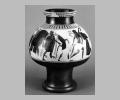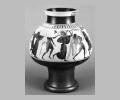| Collection: | Indiana University Art Museum |
| Summary: | Dionysiac thiasos. |
| Ware: | Attic Black Figure |
| Painter: | Attributed to the Rycroft Painter |
| Date: | ca. 520 BC - 510 BC |
| Dimensions: | H. as restored 34.0 cm., D. 26.8 cm., D. of mouth 14.6 cm. |
| Primary Citation: | |
| Shape: | Psykter |
| Beazley Number: | 5187 |
| Period: | Archaic |
Decoration Description:
The subject is a Dionysiac thiasos. Dionysos is mounting a quadriga, holding the reins with both hands. An ithyphallic satyr faces him and raises a kantharos to his lips. Behind him a maenad with krotala dances to right, looking round. At the head of the cortege, Hermes advances to right, also looking round. He is preceded by a satyr playing the flutes and another one moving to right, looking back. Behind the chariot a satyr, carrying a full wineskin on his left shoulder, follows on foot. He looks round at three pairs of satyrs and maenads: the pair closest to him is dancing, the one in the middle is shown in an embrace, and the farthest one, again dancing, moves in the opposite direction. Although the scene is continuous, the three pairs can be called the reverse. It is also not without significance that there are no vines in the background and that the satyrs are not ithyphallic.
Added red: alternate ivy leaves in Dionysos' hair, beard of Dionysos (but not his hair); satyrs' beards (but not hair), satyrs' tails; wings on Hermes' boots; details of chariot box, horses' manes and breastbands in thin lines; occasional fine stripes on garments; alternate elements in tongue-pattern. Added white: flesh of maenads and middle fold of Dionysos' himation (almost totally worn off).
The lip is decorated by an ivy wreath that has an undulating red vine.
An attribution to the Rycroft Painter is borne out by the figure of Hermes that is very close to the Hermes on bis), quater),
The ivy on the rim is close to the ivy on the mouth of the Rycroft Painter's calyx-krater in Toledo (bis) and fragments of calyx-kraters by him in the collections of Iris C. Love and
Shape Description:
Psykters with decorated mouths are rare.
Essay:
Sources Used:


